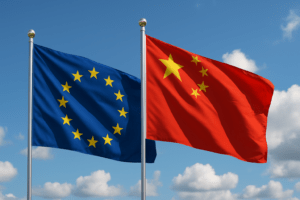2022 is a key for Africa. The dramatic consequences of the Covid-19 pandemic on health and the economy, exacerbated by unequal access to vaccines, risk causing the African continent to take a step backwards and a loss of confidence in solidarity and international cooperation.
The timid economic recovery launched in 2021 must be accompanied by measures that allow the continent to combine economic growth and sustainable development, in line with the goals of the 2030 Agenda of the United Nations and the Agenda 2063 of the African Union. The Green Recovery Plan launched by the African Union in June 2021 for the period 2021-27 recognizes the need for green and resilient recovery as a means to respond to challenges related to climate change, public health, and the economy. The response to these increasingly interconnected challenges must be placed at the center of the partnership between the African continent and the international community.
The COP26 in Glasgow marked some progress in this sense. In fact, important goals were achieved, such as keeping the 1.5-degree objective, the commitment by the richest countries to double the finance for adaptation by 2025, the agreement to protect the forests of the Congo Basin and the important agreement for a just transition in South Africa. Nonetheless, other elements remained pending, especially the issue of Loss & Damage, central to achieving climate justice goals, and on which only a tentative step forward was taken.
COP27, which will be held in November 2022 on the African continent, in Sharm el-Sheikh, represents an important opportunity for the needs of Africa and other developing countries to be heard and receive an adequate response.
In this context, the European Union-African Union summit to be held on February 17-18 in Brussels represents a first key appointment to build, together with Africa, a new partnership based on the following pillars: green transition and access to energy; digital transformation; sustainable growth and employment; peace and security; migration and mobility. The climate dimension unites all of these elements and makes it necessary for Europe to make a strong commitment alongside Africa in both mitigation and adaptation to climate change.
Finance and liquidity for a green and resilient recovery
According to the World Bank’s latest report on the global economic outlook, developing countries risk seeing an abrupt halt in 2022 to the economic recovery that began in 2021 due to inflation, debt and inequality, and the risk of new variants coming up considering that vaccination campaigns have not yet met their targets. The alarm raised by the World Bank echoes that raised last year by the International Monetary Fund about the disparity in the prospects for post-pandemic recovery between developed and developing countries. In fact, the latter have limited fiscal space, due to high public debt and difficulty in accessing international financing. According to the IMF, African economies need a sum of $285 billion to emerge from the pandemic, and at least double that amount to return to pre-pandemic levels.
In this context, the issue of the debt of African countries has once again become a priority both for exiting the pandemic and for climate action. Identifying sustainable methods of debt restructuring is, in fact, necessary to combine these two needs and ensure that the recovery is a green and resilient recovery, in accordance with the objectives of the African Union. With the disappearance, as of January 2022, of two important multilateral mechanisms for debt reduction (the G20 Debt Service Suspension Initiative (DSSI) and the International Monetary Fund’s Catastrophe Containment and Relief Trust (CCRT)), the only remaining mechanism is the G20’s Common Framework for Debt Treatments, which, however, to date has not achieved the desired objectives.
A new fund created by the IMF, the Resilience and Sustainability Trust (RST), agreed under the Italian Presidency of the G20, which should become operational by the end of 2022, aims to support the response to long-term structural challenges such as climate change and pandemic response. Richer countries will be able to allocate part of their Special Drawing Rights to RTD and thus contribute to their redistribution to more fragile economies. In 2021, the British-led G7 and the Italian-led G20 have expressed the ambition to allocate the equivalent of at least 100 billion in Special Drawing Rights to developing countries. At present, there are commitments for 45 billion dollars: an important sum but still not enough to meet the commitments made.
Another central issue for green and resilient recovery is that of access to credit and the persistence of financing difficulties on international markets precisely because of high debt exposure and low positioning in the ratings of international credit agencies. To deal with these difficulties, the United Nations Economic Commission for Africa (UNECA) has put forward a proposal for the creation of a Liquidity and Sustainability Facility (LSF), with the aim of lowering the cost of access to credit and attracting greater investment to the African market. According to UNECA, the facility could make it possible to save around 11 billion dollars a year in interest on debt and should encourage the issue of green bonds by African governments.
The creation of these instruments must go hand in hand with the commitment by developed countries to implement the climate finance commitments made to date: not only the achievement of the goal of 100 billion dollars per year to be allocated to developing countries (a goal initially intended to be achieved by 2020 but not yet reached), but also the goal, outlined at COP26 in Glasgow, of doubling the financial flows to be allocated to adaptation actions by 2025 compared with 2019 levels. Currently, in fact, about 60% of EU funds are allocated to mitigation actions. Finally, it is necessary that these funds do not add to and complicate the already heavy debt situation of developing countries: it is therefore necessary that the form of “grants”, non-repayable contributions, is preferred to that of “loans”, direct loans. If there is no alternative to loans, they must be at concessional rates (concessional loans).
Access to energy and the energy transition
The future of the global energy transition and the ability to limit global warming within 1.5 degrees in a fair way will also come down to energy choices in Africa. While the continent is already suffering severely from the impacts of climate change, it is also the continent that has had the least impact on global emissions at around 2% from the pre-industrial era to today, while at the same time suffering the highest rate of lack of access to electricity.
The International Renewable Energy Agency (IRENA) estimates that there are still 570 million people without access to electricity in Sub-Saharan Africa in 2019. The big challenge today is to achieve electricity access in line with a climate trajectory of 1.5 degrees and Sustainable Development Goal number 7 (SDG7) of universal access by 2030. The International Energy Agency’s (IEA) new scenario for global climate neutrality to 2050 in line with 1.5 and SDG7 shows that access to the electricity grid followed by renewable development is key: “about 45% of those without access to electricity will get it by 2030 through a connection to a main grid, while the rest will be served by mini-grids (30%) and stand-alone solutions (25%). Nearly all off-grid or mini-grid solutions are 100 percent renewable.” This strategy would generate less than 0.2% CO2 emissions.
Moreover, in the 1.5 scenario, while African energy demand varies by country, on average it is not expected to increase despite the expected increase in population. This is because energy efficiency and increasingly efficient electrical services compensate for the increase in demand generated by new access and services, in line with IEA projections for which “global energy demand in 2050 is around 8% lower than today, but a more than double the size of the economy and a population with 2 billion more people is needed.” So there is a need to rethink demand estimates and the actual need for supplies against the new targets.
The issue of new supplies is crucial for the African energy challenge. The IEA 1.5 scenario shows that new oil and gas production is not necessarily required in Africa. For example, the liquefied gas (LNG) supply trend remains constant at current levels until 2030 and then declines. Realizing this trend, however, is possible only if energy choices in Africa fall primarily on energy efficiency, access to the electrical grid and massive development of renewables, whose potential is enormous but largely underdeveloped. According to IRENA, solar has a technical potential of 7900 GW, the highest at global level, but only 0.13% is exploited and three quarters of this is concentrated in South Africa and Egypt. Wind potential is estimated at 461 GW but only 1.4% of this is currently exploited. Renewables can create “nearly three times as many jobs as fossil fuels, per million dollars spent.” However, without developing new industry supply chains and local value chains, along with intra-African trade, it will be difficult to unlock this job potential.
However, investments in renewable energy remains scarce, with few O&G companies investing in this direction in Africa. In contrast, Oil Change International estimates that O&G companies are planning to invest $230 billion by 2030 and up to a total of $1,400 billion by 2050 in exploration and development of new oil and gas projects. This is not only inconsistent with climate and clean energy access goals, but presents a number of financial and security risks. In the 1.5 scenario, most of the value of these investments would be lost as well as expected government revenues. For example, the IEA calculates that “most of the 200 billion cubic meters of LNG projects currently under construction do not recover capital,” estimating losses of $75 billion. In addition, the commercial value of oil and gas will change dramatically over the next 30 years, with an estimated loss in value of at least one-fifth in 2050 compared to 2020. The loss of government revenues from unforeseen collapses in hydrocarbon prices or future devaluations would further weigh on the debts of African countries, causing fiscal and macroeconomic distress that can only be repaired by new debt. For example, in Equatorial Guinea, Chad and Algeria, deficits have exceeded 10% of GDP in 2020. Added to this are significant security and corruption risks linked, directly or indirectly, to the development of large fossil infrastructures or even by the mere promise of future realization, as in the case of gas exploitation in Mozambique.
These scenarios – together with the evidence over the last two decades not only of a failure to generate prosperity and resilience from the development of hydrocarbons, but also from the creation of new instability – raise important questions about the foreign energy policy priorities of European countries, how to respond to the need for access to energy in the most resilient way, and who should bear, or on whom should the risks fall: African governments and citizens, O&G companies or advanced economies? In any case, the climate challenge and the experience accumulated thus far must lead to in-depth reflection that is not tied to individual industrial interests: on the hypotheses of future energy demand; on the benefits assumed by the development of gas and oil compared with actual experience and alternatives; and on what financial support and commercial diplomacy to offer in the face of a multiplicity of risks. All of this, however, must start more from the specific nature of each country than from an undifferentiated approach to the African continent; it cannot ignore the barriers present to the development and spread of clean energy, such as the high cost of capital for African countries and those who bear the costs; and, above all, it must first and foremost come to terms with the requests of African countries and institutions in a process of listening, dialogue and mutual recognition of their responsibilities and rights guided by the common goals and values of cooperation and solidarity.
Adaptation and Loss & Damage (L&D)
Adaptation to climate change has become an increasingly central issue in the run-up to and during COP26, strongly supported by demands from developing countries. The continent’s vulnerability to climate impacts has helped push funding for adaptation and the achievement of the Global Goal on Adaptation (GGA) set by the Paris Agreement to the center of discussions in Glasgow. This focus will be even more pronounced in the work of COP27 to be held in Egypt.
At COP26, the creation of a new work program on GGA was agreed, which aims to advance the understanding and therefore the implementation of this goal in the long term, through the definition of methodologies and indicators for measuring adaptation actions, supporting the implementation of the actions of National Adaptation Plans and communicating the priorities and needs of developing countries on this front. In further recognition of the centrality of this issue and the need for significant support in this area, donors have also committed to doubling financial resources for adaptation actions by 2025 compared with 2019 levels, with the ultimate goal of establishing a balance between support for mitigation and that for adaptation.
The African continent has an urgent need to deploy substantial resources to quickly build its resilience to the inevitable impacts of climate change and provide a solution to its vulnerability in the face of this challenge. In this perspective, the construction of resilient infrastructures will be an absolute priority issue for a continent that has a strong desire for growth and development and will probably be the ground on which the balance between the largest economies on the planet that intend to have a growing role and weight in the area will be played. Beyond the geopolitical challenges and the various initiatives launched in this area by the United States, European Union and United Kingdom, respectively, in the wake of the growing role of China as the main investor in Africa, it remains to be understood how and to what extent the work of COP27 can provide a useful and satisfactory response to the requests of African countries on adaptation.
Another central issue for developing countries addressed at COP26 is the question of the inevitable loss and damage resulting from climate change. Beyond some progress of a technical nature, what clearly emerged was the strong demand led by the most vulnerable countries for the establishment of an autonomous support instrument for the financing of loss and damage suffered that provides innovative means for guaranteeing resources for economic and non-economic losses linked to the negative effects of climate change, also making use of insurance mechanisms for risk transfer. Although the Glasgow Climate Pact provided some initial responses, developing countries, civil society and the international media stressed that the outcome of COP26 fell short of expectations and the complexity of the problem. The strong focus on financial aspects and the geographic dimension of COP27 will inevitably bring to the center of discussions the issue of loss and damage and how the international community can give an adequate and concrete response to this challenge, taking advantage of the wide range of existing and potential financial and support instruments inside and outside the UNFCCC, leveraging above all the international and multilateral financial institutions well equipped to deal with issues of this scale.
In the months leading up to COP27, it will be central to understand what solutions can be agreed upon for L&D at Sharm el-Sheikh; which agencies and programs already have as a priority the avoidance and minimization of climate loss and damage and what resources are already available; what multilateral and international instruments will need to be activated to provide liquidity to developing countries to respond to the increasing devastation resulting from climate change driven extremes; and what role the UNFCCC process can continue to play in managing L&D. Italy, with its strong interest in relaunching its partnership with African countries and its role as a funder of multilateral banks, can play a leading role in this debate by promoting initiatives of great impact outside the UNFCCC context.
Photo by Kyle Glenn on Unsplash







